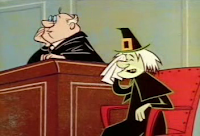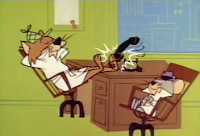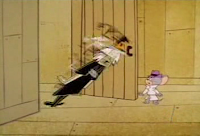 Produced and Directed by Bill Hanna and Joe Barbera.
Produced and Directed by Bill Hanna and Joe Barbera.Credits: Animation – Ken Muse; Layout – Dick Bickenbach; Backgrounds – Fernando Montealegre; Story – Mike Maltese; Story Sketches – Dan Gordon; Titles – Art Goble; Production Supervision – Howard Hanson.
Cast: Snooper, Gretel, Marvin the gorilla, Judge – Daws Butler; Blabber, Witch, Hansel – Elliot Field.
First Aired: week of October 12, 1959.
Production No. J-3.
Plot: Snooper and Blabber testify how they rescued Hansel and Gretel at the trial of the kidnapping witch.
A note from Yowp: Yes, I know you thought for Hallowe’en, I’d run down a cartoon featuring J. Evil Scientist. Sorry. J. Evil Scientist and his one-gag family are on my list of lame H-B characters along with Cindy Bear and Yakky Doodle. Instead, we’ll feature another character appropriate to the season.
It didn’t take long for Mike Maltese to dip into his old oaken bucket into the reservoir of Warner Bros. tricks after arriving at Hanna-Barbera from the Chuck Jones unit. This cartoon combines the plots of a couple of Warners cartoons and Maltese shamelessly lifts a line out of one of them.
First, Maltese borrowed a little more than a pinch of this and a dash of that from Jones’ Bewitched Bunny (1954), written by—surprise!—Mike Maltese, which featured Witch Hazel trying to eat Hansel and Gretel but ends up thwarted by Bugs Bunny. Added to that is the basic plot of Friz Freleng’s The Trial of Mr. Wolf (1941) written by—surprise again!—Mike Maltese, where a wolf testifies in court in his defence against a fairy tale character and makes himself out to be the victim. The character, in that case, is Little Red Riding Hood.
So, now Maltese has his plot. And the cartoon opens with Snooper and Blabber tooling down a city street in their late-‘50s finned car (very similar to the one in their previous effort Puss N’ Booty) as Blabber reads a newspaper headline we can all read for ourselves. The two are set to testify in the trial of a witch, who proclaims her innocence, claiming Hansel and Gretel set her up. One thing Maltese couldn’t borrow from Warners was the voice of Witch Hazel, the wonderful June Foray, so Joe Barbera handed the role to Elliot Field. He sounds a bit like Jonathan Winters doing Maudie Frickert, but it works.


 Anyway, the witch begins to weave her tale of two bratty kids who knock at her door while she’s baking a chocolate pie. “How’s about a handout, sister?” Hansel smugly remarks. The witch hands them the pie. They’re not satisfied. Maltese comes up with some oddball substitutes. They want ketchup malts and mustard sundaes. Before throwing the pie back at her face, Hansel sneers “Ahh, your mother rides a vacuum cleaner” proving he must have seen Bewitched Bunny, too, because Maltese put those words in Hansel and Gretel’s mouths to the witch in that cartoon, too. A nice touch before the scene fades out is the sound of the metal pie plate hitting the ground.
Anyway, the witch begins to weave her tale of two bratty kids who knock at her door while she’s baking a chocolate pie. “How’s about a handout, sister?” Hansel smugly remarks. The witch hands them the pie. They’re not satisfied. Maltese comes up with some oddball substitutes. They want ketchup malts and mustard sundaes. Before throwing the pie back at her face, Hansel sneers “Ahh, your mother rides a vacuum cleaner” proving he must have seen Bewitched Bunny, too, because Maltese put those words in Hansel and Gretel’s mouths to the witch in that cartoon, too. A nice touch before the scene fades out is the sound of the metal pie plate hitting the ground.We iris in to Hansel and Gretel on the stand. “She tried to make a smorgas-boy out of me,” says the innocent-looking Hansel, and we fade to their version of what happened. The dialogue’s cute here. Field and Daws Butler, as Gretel, read their lines like they’re badly reading a script. “We are lost, kind lady.” “We seek food and shelter.” The witch bids them to come in and take a ride in a “sports car”. She even gives them little sports car-riding caps. The sports car turns out to be a roasting pan with wheels (clever, that old crone), as the witch slams the lid on top and kicks “my little blue plate specials” into an old-fashioned stove. The kids escape through the burner holes and are chased around the house “until Snooper and Blabber Mouse came to our rescue.”


 Now we dissolve to Snooper and Blabber on the stand, who relate their version of the events. The next scene is in Snooper’s office, where he kicks the ringing phone off the hook and grabs it. Who rang? And how did they know they were in the witch’s cottage? We’re left to assume the caller probably saw Bewitched Bunny, too. The design choice is really neat here. I like the lines on the stones of the cottage, and in the shutters.
Now we dissolve to Snooper and Blabber on the stand, who relate their version of the events. The next scene is in Snooper’s office, where he kicks the ringing phone off the hook and grabs it. Who rang? And how did they know they were in the witch’s cottage? We’re left to assume the caller probably saw Bewitched Bunny, too. The design choice is really neat here. I like the lines on the stones of the cottage, and in the shutters.
 Snooper explains they spotted “a veritable frankenfurter monster.” The witch, upon hearing they’re detectives looking for the missing children, tells them the only one in her home is Marvin, her pet gorilla, which is a little reminiscent of Paul, the pet tarantula of Witch Hazel in Broom-Stick Bunny (1956) written by—need we tell you? The sceptical detectives get a bit of proof.
Snooper explains they spotted “a veritable frankenfurter monster.” The witch, upon hearing they’re detectives looking for the missing children, tells them the only one in her home is Marvin, her pet gorilla, which is a little reminiscent of Paul, the pet tarantula of Witch Hazel in Broom-Stick Bunny (1956) written by—need we tell you? The sceptical detectives get a bit of proof.What now? “Alimentary, me dear Blabber Mouse,” says Snooper. And they run away. But not so fast. They see, and hear, the kids cry for help. Isn’t that a great little attic shot? I wonder if Dick Bickenbach came up with that in layout or Dan Gordon drew it first. Our heroes decide to batter down the door to the cottage. The witch opens the door, the detectives enter the home, and the stove, still carrying the log. They roll out in the wheeled roasting pan and the witch beats a hasty retreat.


Here are a couple of Monte’s interior backgrounds. Not as outrageous as Ernie Nordli and Maurice Noble’s designs for Witch Hazel at Warners, but I really like the broken, crooked stairwell anyway.


 We get a nice little French bedroom farce-like chase scene involving the witch, Marvin, the children and Snooper and Blabber over the sounds of Jack Shaindlin’s Toboggan Run. It quickens the pace of the cartoon nicely. First, it’s Snooper and Blabber into a room with the witch. Then it’s the gorilla after the detectives. Then it’s the gorilla after Hansel and Gretel into a room. Then it’s the witch in the roasting pan after the children. Snooper times it perfectly to put the cover on the pan, and the witch, to bring her to justice.
We get a nice little French bedroom farce-like chase scene involving the witch, Marvin, the children and Snooper and Blabber over the sounds of Jack Shaindlin’s Toboggan Run. It quickens the pace of the cartoon nicely. First, it’s Snooper and Blabber into a room with the witch. Then it’s the gorilla after the detectives. Then it’s the gorilla after Hansel and Gretel into a room. Then it’s the witch in the roasting pan after the children. Snooper times it perfectly to put the cover on the pan, and the witch, to bring her to justice. It’s not over yet. Into the room they go, and the gorilla chases Snooper, who tries to hide under a ceiling light.
It’s not over yet. Into the room they go, and the gorilla chases Snooper, who tries to hide under a ceiling light.Blabber: Say, Snoop. What are you doing up there?
Snoop: I’m reading a book because the light is better.
Snooper tells Blab to go down to the cellar, get a saw and saw the gorilla from below. But Blab screws up the instructions and saws around the light from above and Snooper lands on Marvin instead.
 So the chase is on again. Snooper and gorilla run into another room. Snooper bolts out and tells Blab to shut the door. He does. There’s a bang. It’s the flattened witch.
So the chase is on again. Snooper and gorilla run into another room. Snooper bolts out and tells Blab to shut the door. He does. There’s a bang. It’s the flattened witch. While I’m at it, let me apologise for the poor quality screen caps. If WHV would bother to spend the money on music rights and put these out on DVD, I’d be very happy.
 Now comes the courtroom climax. The witch demands to bring in a surprise witness. Out she goes and in comes Marvin (the chair at the witness stand has changed somehow in the last few seconds), who testifies “The witch is a sweet old lady. Them kids is guilty.” Hansel indignantly shouts that the gorilla is fibbing “Just like that ugly old witch.”
Now comes the courtroom climax. The witch demands to bring in a surprise witness. Out she goes and in comes Marvin (the chair at the witness stand has changed somehow in the last few seconds), who testifies “The witch is a sweet old lady. Them kids is guilty.” Hansel indignantly shouts that the gorilla is fibbing “Just like that ugly old witch.” “Ugly?! Who’s ugly?” says the gorilla, who now has the witch’s voice. And it turns out the witch is really Marvin as she removes her head. She realises her faux pas as the judge declares her guilty. “Well, hee hee, can’t blame a girl for trying,” says the witch philosophically to end the cartoon.
“Ugly?! Who’s ugly?” says the gorilla, who now has the witch’s voice. And it turns out the witch is really Marvin as she removes her head. She realises her faux pas as the judge declares her guilty. “Well, hee hee, can’t blame a girl for trying,” says the witch philosophically to end the cartoon.Some of the music selections are a little unusual for a Snooper cartoon, which avoided using tunes by Bill Loose and John Seely. And I don’t believe Toboggan Run was used again; there was other Shaindlin chase music in later cartoons and you can hear some of it here. All Phil Green compositions are the original names from EMI.
0:00 - Snooper and Blabber Main Title theme (Hoyt Curtin)
0:24 - TC-432 HOLLY DAY (Loose-Seely) – Blabber reads headline, witch on stand, flashback to Hansel and Gretel arriving at witch’s cottage.
1:30 - L-1139 ANIMATION COMEDY (Moore) – Hansel and Gretel testify.
1:46 - Suspenceful music (Shaindlin) – Kids put in “sports car”; witch chases them in house.
2:39 - GR-75 POPCORN SHORT BRIDGE (Philip Green) – Snooper and Blabber on the stand, Snoop answers phone.
2:55 - GR-78 CUSTARD PIE CAPERS SHORT BRIDGE (Green) – Snoop and Blab get in car.
3:08 - GR-334 LIGHT AGITATED BRIDGE (Green) – “What’s wrong with a little hero worship?”
3:21 - GR-93 DRESSED TO KILL (Green) – Snooper and Blabber arrive at witch’s cottage, gorilla pounds on Snooper, kids scream for help.
4:31 - F-5-20 TOBOGGAN RUN (Shaindlin) – Battering ram, chase, witch captured in roasting pan.
5:05 - circus music (Shaindlin) – Snooper and Blabber carry pan.
5:27 - vaudeville music (Shaindlin) – Snoop hides in light, Blab saws down Snoop.
6:04 - circus music reprise (Shaindlin) – Snoop runs from gorilla; witch runs into door.
6:19 - GR-90 THE CHEEKY CHAPPIE (Green) – “Excuse me, madame”, Witch demands to bring in surprise witness.
6:37 - GR-96 BY JIMINY! IT’S JUMBO (Green) – Gorilla testifies, Hansel cries “liar.”
6:55 - GR-77 CUSTARD PIE CAPERS (Green) – Witch reveals she’s gorilla.
7:09 - Snooper and Blabber end title theme (Curtin).























































